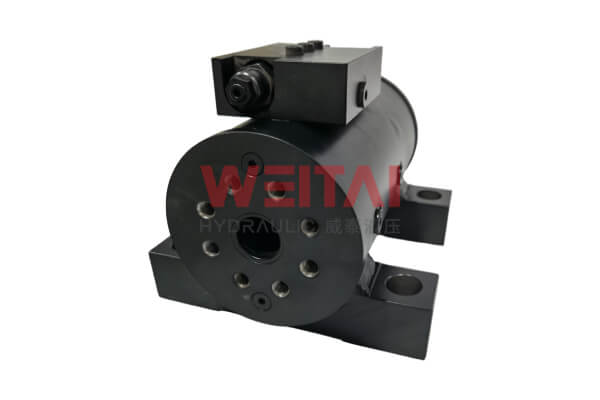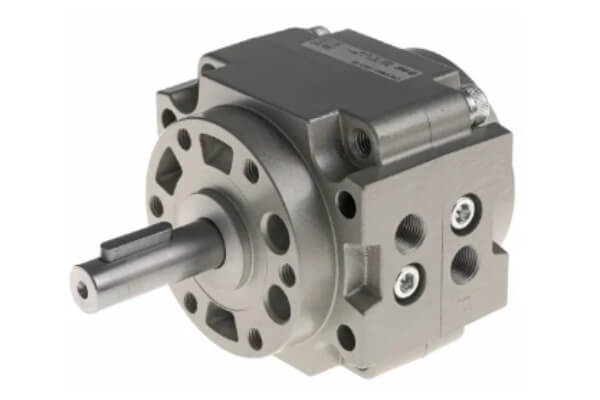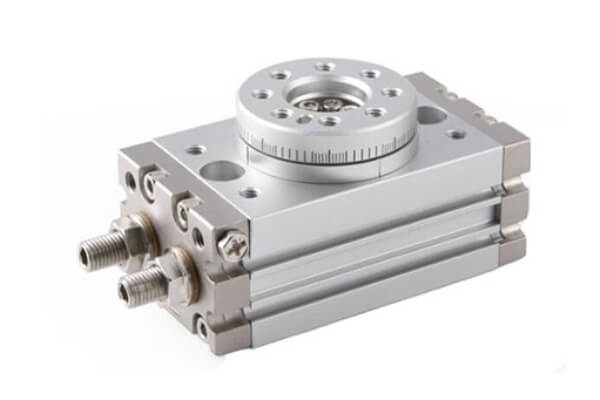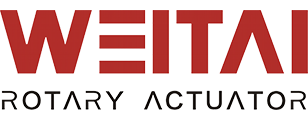Generally, there are 3 types of rotary actuators that are used in different machineries, hydraulic, electric, and pneumatic. Do you know what they are and what field they are applied most? In this post, WEITAI will give you a deep look at the 3 types of rotary actuators.
Hydraulic Rotary Actuator
A hydraulic rotary actuator is a mechanical device that converts hydraulic fluid pressure into rotational motion.
It typically consists of a cylinder or housing, a piston or rotor, and seals to prevent fluid leakage. When pressurized hydraulic fluid is introduced into the actuator, it forces the piston or rotor to rotate, generating the desired rotational movement.
The amount and direction of the rotation can be precisely controlled by regulating the flow and pressure of the hydraulic fluid. Hydraulic rotary actuators are known for their ability to produce high torque and power output, making them suitable for applications that require significant rotational force.

Advantages of a Hydraulic Rotary Actuator
High Power Density: Hydraulic rotary actuators can generate large torque and rotational force in a relatively small size, making them suitable for applications where space is limited but high-power output is required.
Precise Control: They offer precise control over rotational motion, allowing for accurate positioning and movement.
High Load Capacity: Capable of handling heavy loads and withstanding high mechanical stress.
Fast Response: Provide quick response times, enabling rapid changes in rotational speed and direction.
Durability and Reliability: Built to withstand harsh operating conditions and have a long service life.
Applications of Hydraulic Rotary Actuators
Industrial Machinery: Used in manufacturing equipment such as presses, machine tools, and material handling systems.
For example, in a metal stamping press, the hydraulic rotary actuator ensures precise and powerful movement for efficient production.
Construction Equipment: Found in cranes, excavators, and concrete pumps.
Like in an excavator’s arm rotation mechanism, providing the necessary torque for smooth and controlled operation.
Aerospace: Employed in aircraft landing gear systems and flight control surfaces.
Marine Systems: Applied in ship steering systems and winches.
Robotics: Helps in robotic arms and joints for precise and powerful rotational movements.
Electric Rotary Actuator
An electric rotary actuator is a device that converts electrical energy into rotational motion.
It usually contains an electric motor, gears or other transmission components, and a control system. The electric motor provides the driving force, and the gears or transmissions adjust the speed and torque to achieve the desired rotational output.
The control system allows for precise control of the rotation speed, angle, and direction. Electric rotary actuators offer several advantages, such as accurate positioning, programmable operation, and relatively quiet and clean operation compared to other types of actuators.

Advantages of an Electric Rotary Actuator
Energy Efficiency: Electric rotary actuators are often more energy-efficient compared to other types of actuators, reducing operational costs over time.
Clean and Quiet Operation: They produce less noise and do not emit pollutants, making them suitable for environments where noise and cleanliness are important, such as in laboratories or cleanrooms.
Precise Positioning: Can achieve highly accurate and repeatable positioning, which is crucial in applications that require fine control and precision.
Ease of Integration: Electric rotary actuators are relatively easy to integrate with electronic control systems and can be programmed and controlled digitally.
Low Maintenance: Generally, it has fewer moving parts and do not require regular fluid changes or seal replacements, reducing maintenance requirements.
Applications of Electric Rotary Actuators
Automation Systems: Widely used in industrial automation processes, including assembly lines, packaging machines, and conveyor systems. For instance, in a packaging machine, an electric rotary actuator precisely rotates and positions the packaging material.
Medical Equipment: Found in medical devices such as surgical robots, imaging machines, and patient positioning systems. In a surgical robot, it enables precise movement of the robotic arms for accurate surgical procedures.
Robotics: Act as key components in robotic joints, providing controlled rotational motion for various tasks.
Aerospace: Utilized in aircraft control surfaces and satellite positioning systems.
Valve Control: Commonly employed in industrial valve control applications to accurately regulate the flow of fluids or gases.
Pneumatic Rotary Actuator
A pneumatic rotary actuator is a device that converts the energy of compressed air into rotational motion.
It typically consists of a cylinder or housing, a piston or rotor, and seals to contain the compressed air. When pressurized air is introduced into the actuator, it acts on the piston or rotor, causing it to rotate.
Pneumatic rotary actuators are known for their fast response and simple design. They are often used in applications where quick and repetitive rotational movements are required.

Advantages of a Pneumatic Rotary Actuator
Fast Action: Pneumatic rotary actuators offer rapid response times, enabling quick rotational movements.
Simple Design: They have a relatively simple construction, which leads to lower costs and easier maintenance.
Lightweight: Are often lightweight, making them suitable for applications where weight is a critical factor.
Safe Operation: Pneumatic systems are generally considered safe as they do not pose the risk of electrical shock or fire.
Resistance to Harsh Environments: Can operate effectively in dusty, wet, or high-temperature environments.
Applications of a Pneumatic Rotary Actuator
Manufacturing: Used in various manufacturing processes such as in automotive assembly lines for component positioning and manipulation.
For example, in the automotive industry, they can quickly rotate components for efficient assembly.
Food and Beverage Processing: Employed in food processing equipment where hygiene and quick operation are essential.
Like in a bottling line, pneumatic rotary actuators can rapidly rotate the bottles for filling and capping.
Packaging Industry: Found in packaging machines for tasks like folding, sealing, and orienting packages.
Material Handling: Help in the movement and orientation of materials in conveyor systems and sorting equipment.
Printing Industry: Utilized in printing presses for paper feeding and alignment.
In Summary
Above we can see, different type of rotary actuator has its own advantages and applications. We need to choose the proper one to match the project.
WEITAI is an experienced and professional manufacturer of hydraulic rotary actuator in China. Should you have any questions about hydraulic rotary actuators, please feel free to contact us. We will do our best to help you.
